Optimal Scheduling and Comprehensive Evaluation of Distributed Resource Aggregator Low-Carbon Economy Considering CET-RPS Coupling Mechanism
Abstract
1. Introduction
- How can the carbon quota mechanism of electric vehicles be designed and verified so that the space–time scheduling capability of EVs can be quantified as tradable emission reduction benefits and effectively encourage owners and operators to participate in the carbon market?
- On the basis of considering EV carbon emission reduction, how can the renewable energy green certificates (TGCs) be linked with the carbon quotas (CET), and can a mutual recognition or deduction mechanism be established to avoid repeated measurement and amplify the benefit transmission?
- Under the joint action of multiple types of distributed resources, how can aggregators build a feasible scheduling and market participation model under the dual objectives of economic cost and carbon emissions to achieve the coordination of low carbon and economic benefits?
- How can the comprehensive performance of the proposed mechanism and model be evaluated in terms of cost saving, carbon emission reduction, and operation and maintenance feasibility?
2. Methodology
2.1. Controlled Charging and Discharging Model of Electric Vehicles
2.1.1. Daily Mileage of Electric Vehicles
2.1.2. Charge and Discharge Power
2.1.3. Charge and Discharge Durations
2.1.4. Controlled Charging and Discharging Strategy
2.2. The CET-RPS Convergence Trading Mechanism Considering the Carbon Quotas of Electric Vehicles
2.2.1. Carbon Emission Trading Mechanism Considering Carbon Quotas for Electric Vehicles
- Carbon quotas for electric vehicles
- 2.
- Ladder Carbon Emission Trading Model
2.2.2. Renewable Portfolio Standard Mechanism
2.2.3. Carbon Emission Trading–Renewable Portfolio Standard Convergence Trading Mechanism
2.3. Optimal Scheduling Model
2.3.1. Objective Function
- Economic objectives
- 2.
- Carbon emission targets
2.3.2. Constraint Conditions
- 1.
- Constraints of microturbines
- 2.
- Constraints of electric vehicles
- 3.
- Constraints of distributed flexible load
- Reducible loads:
- Transferable load:
- Shiftable loads:
- 4.
- Constraints of energy storage
- 5.
- Constraints on grid transactions
- 6.
- Constraints of aggregator power balance
2.3.3. Solution Methods
- 1.
- Big-M method
- 2.
- Constraint method
2.4. The Overall Evaluation System of DRA Internal Resources and Aggregators for Optimal Scheduling
2.4.1. Distributed Resource Evaluation System Within Aggregators
- 1.
- Evaluation index of internal distributed resources
- 2.
- Satisfaction model
- (1)
- Electricity satisfaction
- Reducible loads:
- Transferable and shiftable loads:
- Electric vehicles:
- (2)
- Financial satisfaction
- Economic satisfaction of distributed flexible load:
- Economic satisfaction of electric vehicles:
- (3)
- Comprehensive satisfaction degree
2.4.2. Aggregator Overall Evaluation System
3. Analysis
3.1. Parameter Settings
3.2. Verification of CET-RPS Cohesion Mechanism
3.2.1. Comparison of Different Scenarios
3.2.2. Scene 4 Result Analysis
3.3. Results of DRA Low-Carbon Economy Optimal Scheduling Based on ε-Constraint Method
3.4. Optimization Scheduling Evaluation Results
3.4.1. Internal Resource Evaluation
3.4.2. Overall Evaluation of Load Quotient
4. Results
- An optimal scheduling model with a distributed resource aggregator (DRA) as the main body, covering photovoltaic power, wind power, energy storage, electric vehicles, and other resources was constructed to realize the collaborative scheduling of internal resources and power grid interaction. It provided a method basis and practical path for realizing the integrated management of source–load–storage, enhancing the system autonomic ability and supporting the low-carbon transformation of a new power system.
- Compared with the control scenario (Scene 3) without the implementation of the convergence mechanism, the model (Scene 4) proposed in this paper generated CNY 670.21 carbon trading revenue by converting surplus green certificates into deductible carbon emission reduction and realizing carbon trading, so that the total cost of DRA was reduced from CNY 3246.75 to CNY 2486.90, a decrease of 23.4%, indicating that the convergence of CET-RPS significantly improves the utilization efficiency of carbon assets and economic competitiveness.
- Aiming at the diversity of DRA scheduling objectives, the ε-constraint method was used to achieve dual-objective optimization, and the analysis was carried out from the two dimensions of economic cost minimization and carbon emission minimization. The results of the example show that, as the ε was relaxed from 2700 t to 3000 t, the total cost was reduced from CNY 2537.32 to CNY 2487.74, which reveals the impact of carbon emission constraint lending on marginal cost.
- This paper constructed a systematic evaluation system of scheduling effect; accurately identified the scheduling effect from the two levels of internal distributed resources and the overall system of aggregators; revealed the differences and complementary relationships of various resources in satisfaction, flexibility, and economy; and quantified the comprehensive benefits of optimization strategies in system autonomy, carbon emission reduction, and cost control, so as to provide reliable support for aggregators to achieve fine management and synergy.
5. Discussion
- (1)
- Idealized assumptions regarding electric vehicle travel rules and charging and discharging behaviors are made in the modeling, which does not fully reflect individual differences;
- (2)
- The data of the example is typical, but the sample size is limited, so it needs to be verified by larger-scale measurement.
- (3)
- The model relies on a clear CET and RPS system design, and policy differences in different regions may affect applicability;
- (4)
- The dynamic factors, such as battery degradation, long-term price fluctuation, and user behavior evolution, are not fully considered, and the long-term economy still needs further analysis.
6. Conclusions Implications and Future Works
- (1)
- The model could be docked with the actual market settlement mechanism to study the compliance trading path of carbon and green certificates;
- (2)
- Extending to cross-regional and cross-market scenarios, the impacts of transmission constraints and price differences on the effectiveness of the mechanism could be analyzed.
- (3)
- Behavior and risk modeling could be introduced to evaluate the heterogeneity and long-term stability of different market players.
- (4)
- Verification research could be conducted based on measured or pilot data to enhance the universality and policy guidance value of the model.
Author Contributions
Funding
Institutional Review Board Statement
Informed Consent Statement
Data Availability Statement
Conflicts of Interest
References
- Wu, W.; Zhang, B.; Sun, H.; Wang, B.; Yang, Y.; Liu, H.; Lin, C.; Wang, S. Energy management and distributed energy resources cluster control for active distribution networks. Autom. Electr. Power Syst. 2020, 44, 111–118. [Google Scholar]
- Sheng, W.; Wu, M.; Ji, Y.; Kou, L.; Pan, J.; Shi, H.; Niu, G.; Wang, Z.G. Key techniques and engineering practice of distributed renewable generation clusters integration. Proc. CSEE 2019, 39, 2175–2186. [Google Scholar]
- Riaz, S.; Mancarella, P. Modelling and characterisation of flexibility from distributed energy resources. IEEE Trans. Power Syst. 2021, 37, 38–50. [Google Scholar] [CrossRef]
- Yi, Z.; Xu, Y.; Gu, W.; Yang, L.; Sun, H. Aggregate operation model for numerous small-capacity distributed energy resources considering uncertainty. IEEE Trans. Smart Grid 2021, 12, 4208–4224. [Google Scholar] [CrossRef]
- Muller, F.L.; Szabo, J.; Sundstrom, O.; Lygeros, J. Aggregation and disaggregation of energetic flexibility from distributed energy resource. IEEE Trans. Smart Grid 2017, 10, 1205–1214. [Google Scholar] [CrossRef]
- Peik-Herfeh, M.; Seifi, H.; Sheikh-El-Eslami, M.K. Decision making of a virtual power plant under uncertainties for bidding in a day-ahead market using point estimate method. Int. J. Electr. Power Energy Syst. 2013, 44, 88–98. [Google Scholar] [CrossRef]
- Silva, M.; Sousa, T.; Ramos, S.; Vale, Z.; Morais, H. Distributed energy resources scheduling considering real-time resources forecast. In Proceedings of the 2014 IEEE PES General Meeting|Conference & Exposition, IEEE, National Harbor, MD, USA, 27–31 July 2014; pp. 1–5. [Google Scholar]
- Yang, Q.; Wang, H.; Wang, T.; Zhang, S.; Wu, X.; Wang, H. Blockchain-based decentralized energy management platform for residential distributed energy resources in a virtual power plant. Appl. Energy 2021, 294, 117026. [Google Scholar] [CrossRef]
- Muhtadi, A.; Pandit, D.; Nguyen, N.; Mitra, J. Distributed energy resources based microgrid: Review of architecture, control, and reliability. IEEE Trans. Ind. Appl. 2021, 57, 2223–2235. [Google Scholar] [CrossRef]
- Gough, M.; Santos, S.F.; Lotfi, M.; Javadi, M.S.; Osorio, G.J.; Ashraf, P.; Castro, R.; Catalao, J.P.S. Operation of a technical virtual power plant considering diverse distributed energy resources. IEEE Trans. Ind. Appl. 2022, 58, 2547–2558. [Google Scholar] [CrossRef]
- Kang, C.; Du, E.; Li, Y.; Zhang, N.; Chen, Q.; Guo, H.; Wang, P. Key scientific problems and research framework for carbon perspective research of new power systems. Power Syst. Technol. 2022, 46, 821–833. [Google Scholar]
- Chen, J.; Hu, Z.; Chen, Y.; Chen, J.; Chen, W.; Gao, M.; Lin, M.; Du, Y. Thermoelectric optimization of integrated energy system considering ladder-type carbon trading mechanism and electric hydrogen production. Electr. Power Autom. Equip. 2021, 41, 48–55. [Google Scholar]
- Ren, H.; Wang, N.; Wu, Q. Collaborative optimal scheduling and cost allocation of multiload aggregator considering ladder-type carbon trading. Electr. Power Constr. 2024, 45, 171–182. [Google Scholar]
- Chen, Z.; Lu, Y.; Xing, Q.; Chen, X.; Leng, Z. Dispatch analysis of power system considering carbon quota for electric vehicle. Autom. Electr. Power Syst. 2019, 43, 44–51. [Google Scholar]
- Zhang, M.; Liu, S.; Pan, Z.; Zhang, W. Optimal Dispatching of Park-level Integrated Energy System Considering Carbon Quotas for Electric Vehicles. Electr. Power Sci. Eng. 2025, 41, 29–39. [Google Scholar]
- Jiang, Y.; Cao, H.; Yang, L.; Fei, F.; Li, J.; Lin, Z. Mechanism design and impact analysis of renewable portfolio standard. Autom. Electr. Power Syst. 2020, 44, 187–199. [Google Scholar]
- Zhang, X.; Chen, Z.; Ma, Z.; Xia, Q.; Dai, X. Study on electricity market trading system adapting to renewable portfolio standard. Power Syst. Technol. 2019, 43, 2682–2690. [Google Scholar]
- Liang, J.; Zuo, Y.; Zhang, Y.; Zhao, X. Energy-saving and economic dispatch of power system containing wind power integration under renewable portfolio standard. Power Syst. Technol. 2019, 43, 2528–2534. [Google Scholar]
- Shang, N.; Chen, Z.; Lu, Z.; Leng, Y. Interaction principle and cohesive mechanism between electricity market, carbon market and green power certificate market. Power Syst. Technol. 2023, 47, 142–154. [Google Scholar]
- Cui, Y.; Shen, Z.; Wang, Z.; Wang, M.; Zhao, Y. Green dispatch of regional integrated energy system considering green certificate-carbon emission equivalent interaction mechanism. Proc. CSEE 2023, 43, 4508–4517. [Google Scholar]
- Wu, W.; Yu, Y.; Zhang, Y.; Shi, J. Low-Carbon Economic Dispatch of the Integrated Energy Service Station Considering Life Cycle Carbon Emission and Green Certificate-Carbon Joint Trading. Power Syst. Clean Energy 2025, 41, 58–67. [Google Scholar]
- Wang, S.; Wu, W. Aggregation reference model and quantitative metric system of flexible energy resources. Autom. Electr. Power Syst. 2024, 48, 1–9. [Google Scholar]
- Liu, J.; Feng, H.; Ding, N.; Ye, J.; Zhang, C.; Xu, Y. Comprehensive benefit evaluation method for park with distributed resource clusters by electrical and carbon synergy. J. Electr. Power Sci. Technol. 2024, 39, 181–191. [Google Scholar]
- Tang, W.; Gao, F. Optimal operation of household microgrid day-ahead energy considering user satisfaction. High Volt. Eng. 2017, 43, 140–148. [Google Scholar]
- Liu, J.; Li, P.; Zhong, W.; Wang, L.; An, Y.; Li, H. Optimal charging/discharging strategy of electric vehicles in residential area considering user comprehensive satisfaction. E3S Web Conf. EDP Sci. 2018, 53, 02012. [Google Scholar] [CrossRef]
- Yan, X.W.; Wang, Q.; Lu, J.; Bu, J.; Shen, Z. Microgrid energy scheduling with electric vehicles and flexible loads. Power Syst. Prot. Control 2023, 51, 69–79. [Google Scholar]
- Mao, T.; Huang, N.; Cheng, R.; Zhou, B.; Xie, P. Construction for the benefit evaluation index system of virtual power plant and its example analysis. South. Power Syst. Technol. 2021, 16, 124–131. [Google Scholar]
- Jiang, Z.; Zhang, F.; Hu, F.; Sun, Y.; Jiang, W.; Deng, Y. Evaluation method of aggregated responsiveness of distributed resources in virtual power plant. Electr. Power Eng. Technol. 2022, 41, 39–49. [Google Scholar]
- China Climate Change Info-Net. CM-001-V01 Integrated baseline methodology for grid-connected renewable energy generation projects (Version 1) [EB/OL]. 2020, 03-11. Available online: https://www.ccchina.org.cn/archiver/cdmcn/UpFile/Files/Default/20130311164212571089.pdf (accessed on 1 August 2025).
- Liu, J.; Nie, J.; Cui, X.; Liu, P.; Tong, P.; Liu, X. Optimal Energy Configuration of Integrated Energy Community Considering Carbon Emission. Sustainability 2024, 16, 728. [Google Scholar] [CrossRef]
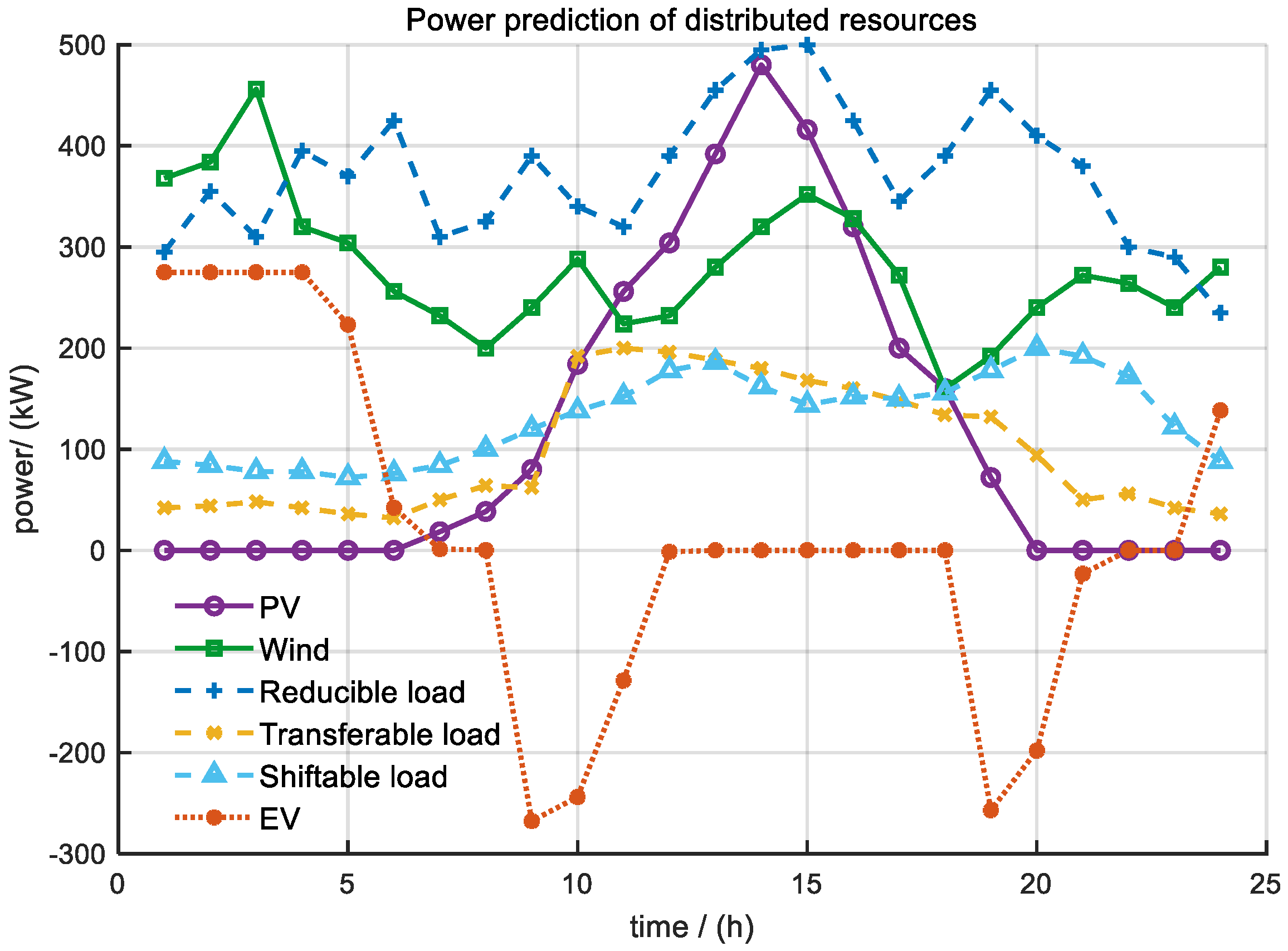
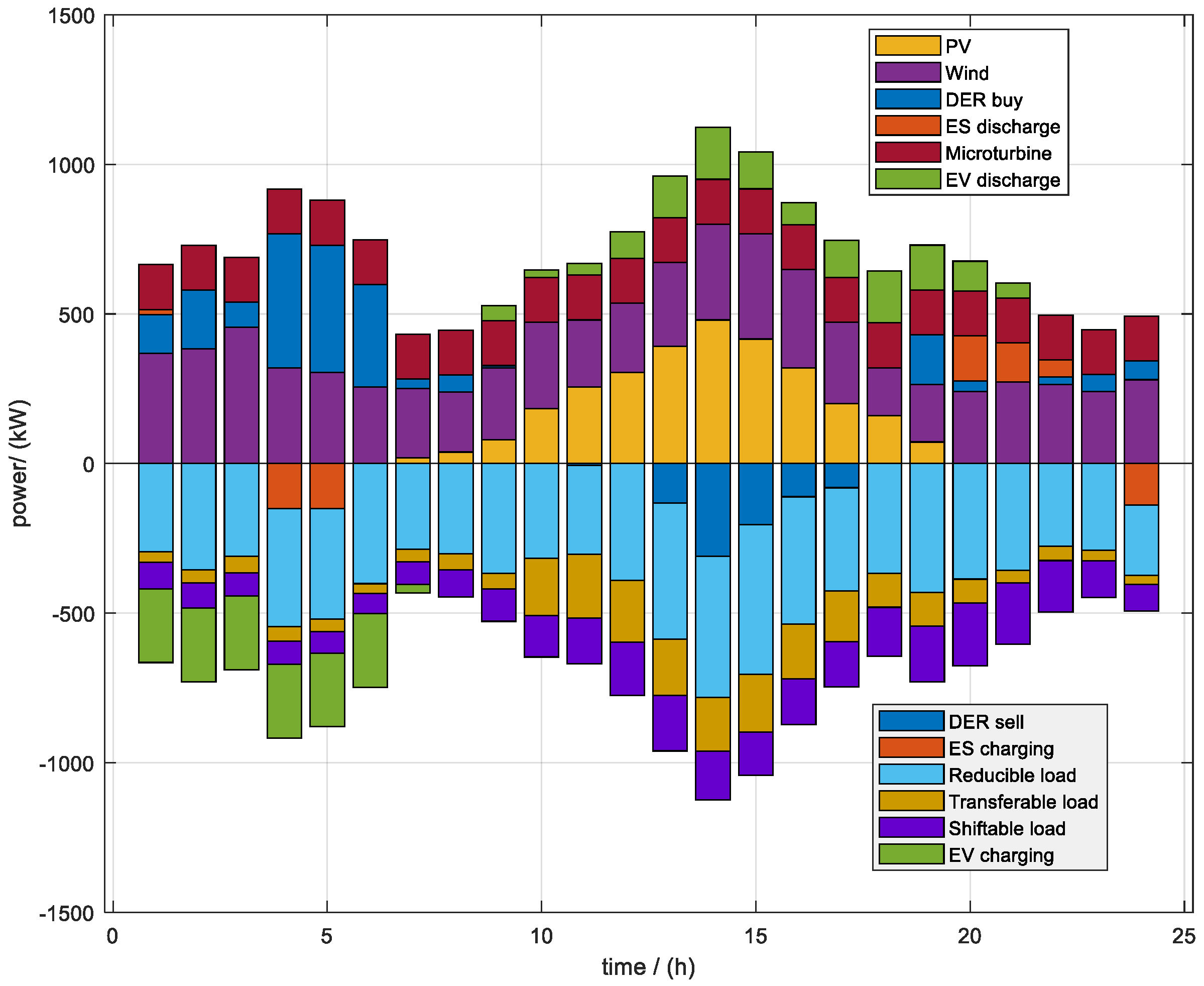
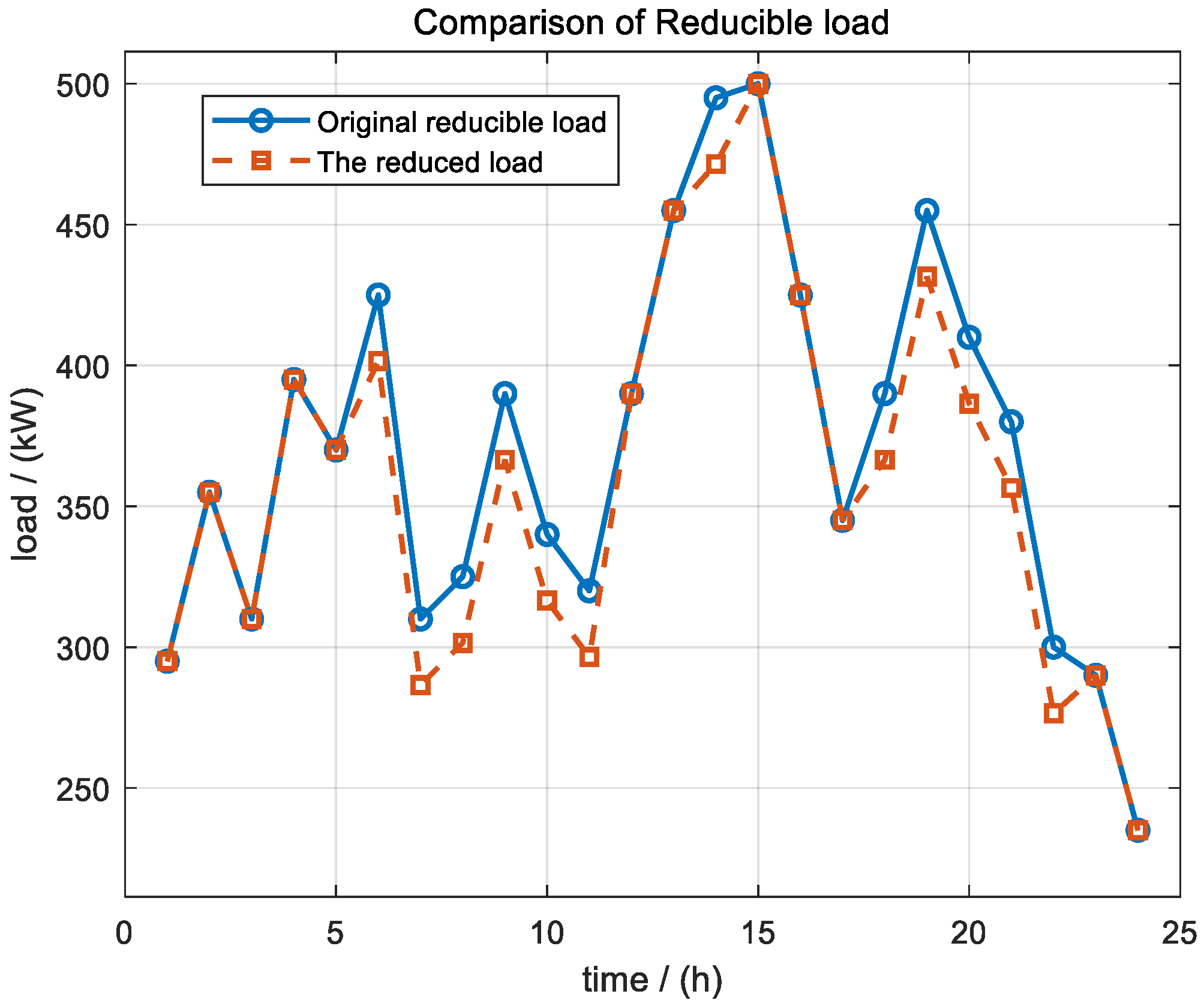
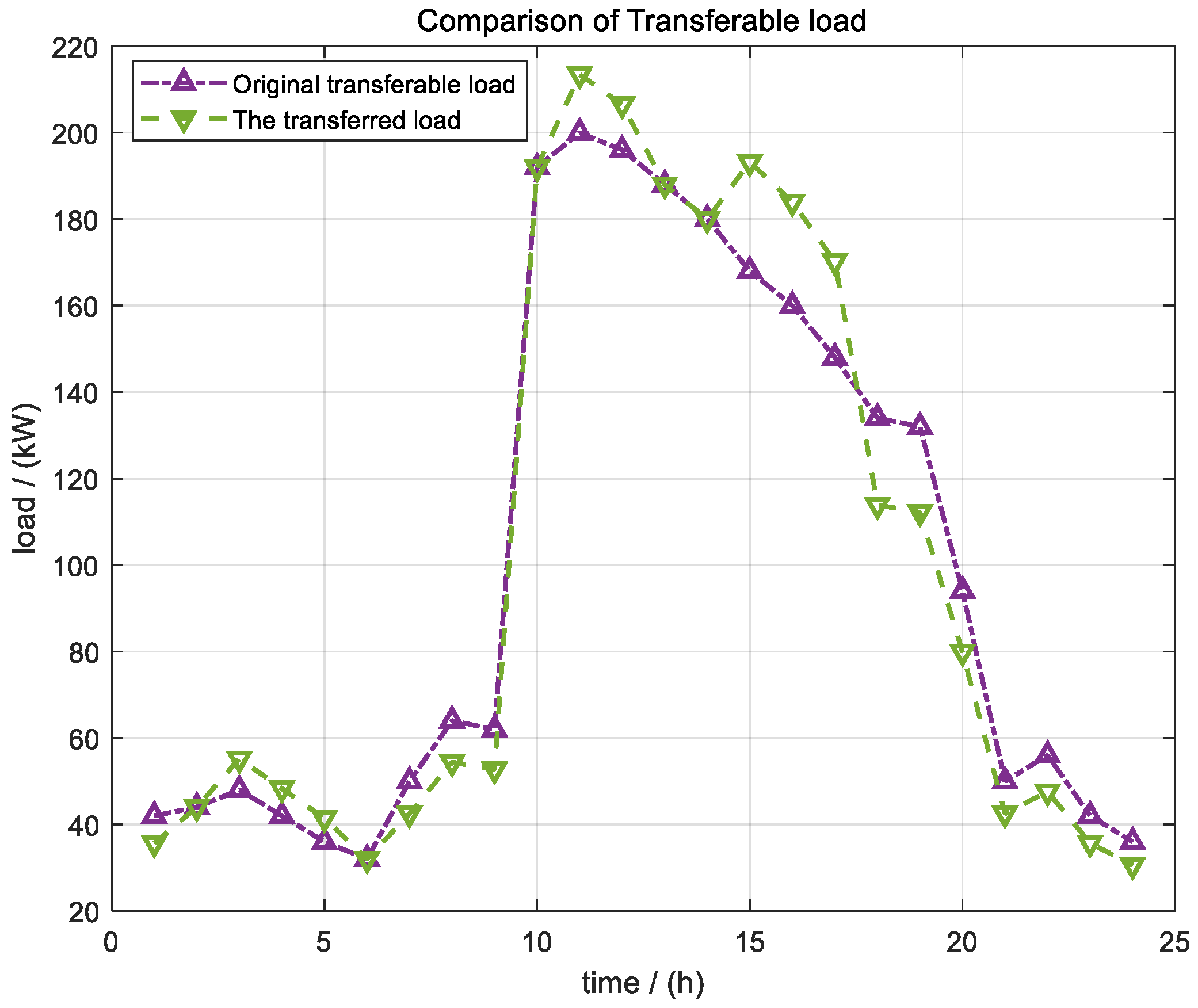

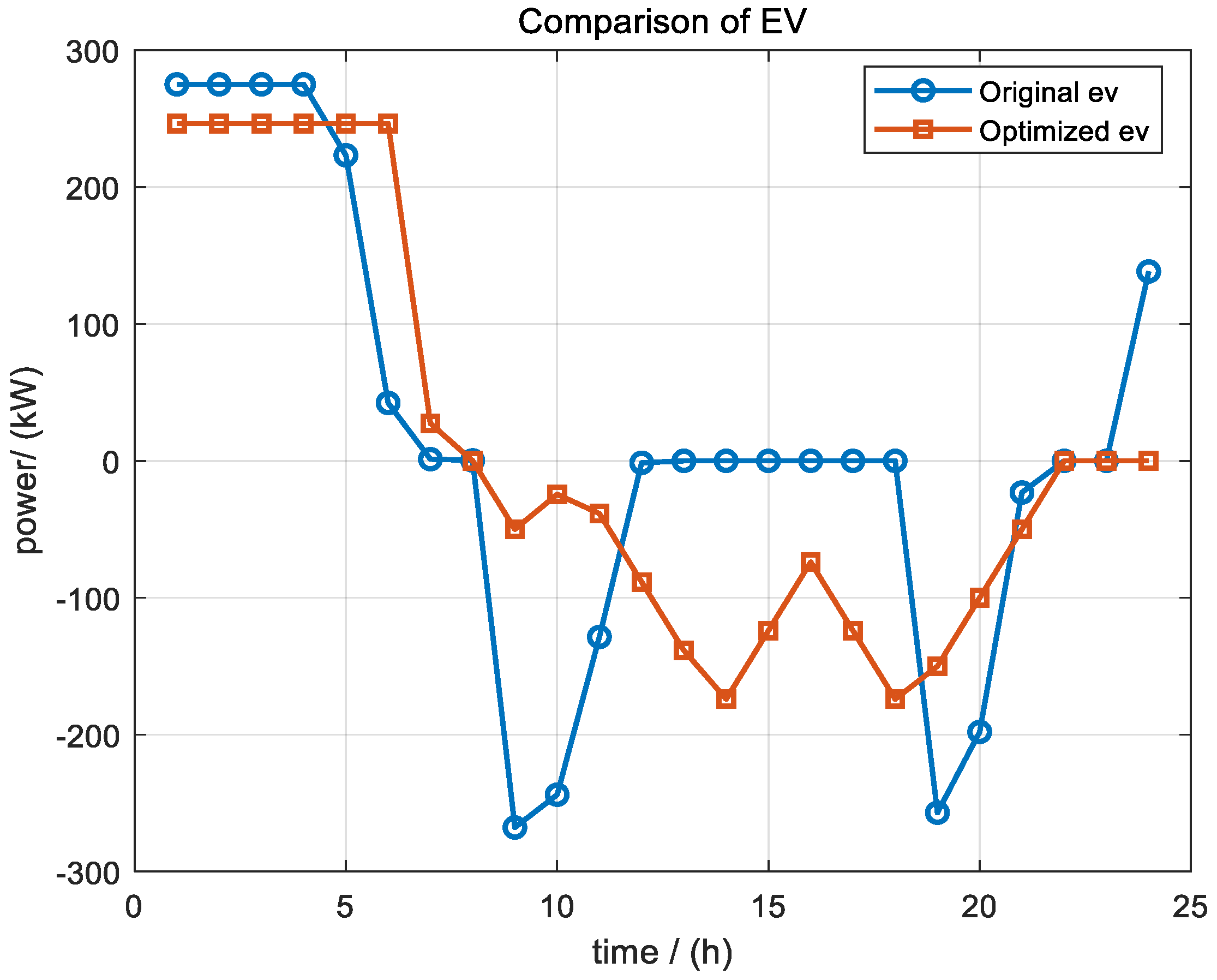
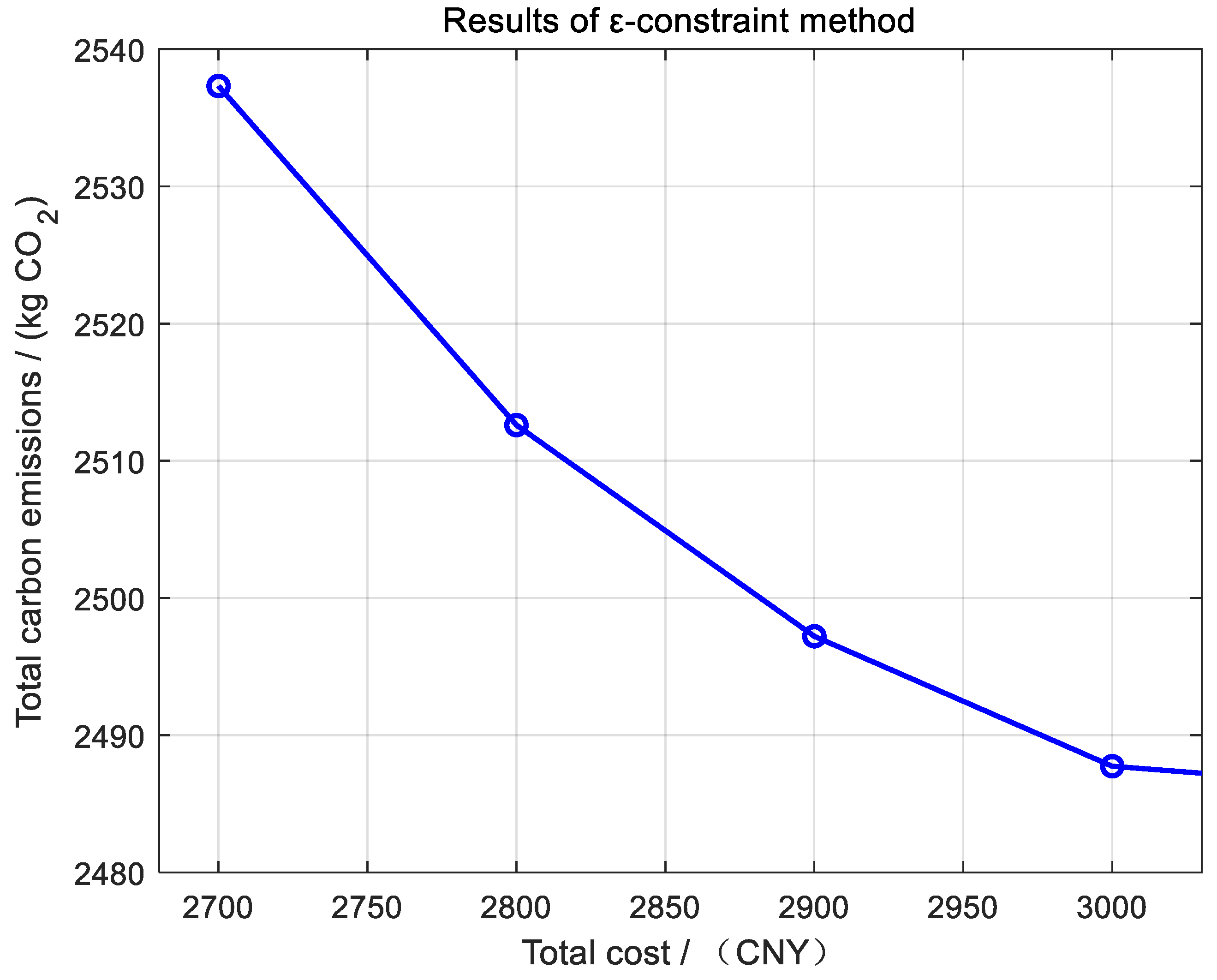
| First-Level Indicators | Second-Level Indicators | Explanation |
|---|---|---|
| Satisfaction | Electricity satisfaction | The satisfaction degree of resources to the implementation of electricity plan |
| Economic satisfaction | The economic benefit satisfaction of resources obtained by participating in scheduling | |
| Comprehensive satisfaction | The overall satisfaction of resources to electricity and economy | |
| Flexibility | Regulating amplitude | Percentage of adjustable power during the scheduling period |
| Duration | The longest time for sustainable adjustment of resources | |
| Economy | Adjusting costs | The cost of DRA regulating resources |
| Profit–cost ratio | The ratio of adjustment income to adjustment cost |
| First-Level Indicators | Second-Level Indicators | Explanation |
|---|---|---|
| Electrical characteristics | Peak–valley difference | The difference between peak load and valley load |
| Total electricity consumption | Aggregator’s total electricity | |
| Adjustable load participation rate | The ratio of adjustable load | |
| Energy structure | The proportion of clean energy power generation | The proportion of renewable energy power generation to total power generation |
| Energy self-supply rate | The proportion of aggregator’s own energy in total energy demand | |
| Environmental benefits | Total carbon emissions | The total carbon emissions of the aggregator as a whole |
| Carbon intensity per unit of electricity | Carbon emissions generated by electricity consumption per unit of aggregator | |
| Economic benefits | Total cost | Aggregator’s total operating cost |
| Policy synergy benefits | The additional benefits generated by the linkage between CET and RPS policies |
| Parameter | Value | Parameter | Value |
|---|---|---|---|
| Microturbine | 0.00027 | Green certificate quota coefficient | 0.0004 |
| Microturbine | 0.026 | Green certificate price | CNY 220 |
| Microturbine | 48 | Carbon trading benchmark price | 0.268 |
| Photovoltaic power | 0.12 | Price growth rate | 0.1 |
| Wind power | 0.15 | Carbon emission interval length | 10 |
| Energy storage | 0.08 | Electricity marginal emission factor | 0.9419 |
| Battery loss of electric vehicle | 0.0843 | Capacity marginal emission factor | 0.4819 |
| Electric vehicle discharge subsidy | 2 | Reducible load compensation price | 0.35 CNY/kW·h |
| Translatable load compensation price | 0.08 CNY/kW·h | Transferable load compensation price | 0.1 CNY/kW·h |
| CET and RPS | EV Carbon Quotas | Convergence Mechanism | |
|---|---|---|---|
| Scene 1 | × | × | × |
| Scene 2 | √ | × | × |
| Scene 3 | √ | √ | × |
| Scene 4 | √ | √ | √ |
| Carbon Trading Cost | Total Cost | Carbon Trading Volume | |
|---|---|---|---|
| Scene 1 | \ | 3892.69 | \ |
| Scene 2 | 354.62 | 3510.09 | 1105.618 |
| Scene 3 | 88.71 | 3246.75 | 228.4723 |
| Scene 4 | −670.21 | 2486.90 | −2542.99 |
| ε | Total Cost | Carbon Emission |
|---|---|---|
| 2600 | \ | \ |
| 2700 | 2537.32 | 2700.00 |
| 2800 | 2512.60 | 2800.00 |
| 2900 | 2497.21 | 2900.00 |
| 3000 | 2487.74 | 3000.00 |
| 3100 | 2486.77 | 3008.10 |
| First-Level Indicators | Second-Level Indicators | Reducible Load | Transferable Load | Shiftable Load | EV |
|---|---|---|---|---|---|
| Electricity satisfaction | 96.82% | 90.46% | 97.59% | 81.30% | |
| Satisfaction | Economic satisfaction | 102.13% | 100.80% | 99.19% | 116.39% |
| Comprehensive satisfaction | 100.27% | 95.63% | 98.15% | 97.09% | |
| Regulating amplitude | 6.36% | 12.76% | 10.00% | 32.74% | |
| Flexibility | Duration | 12 h | 8 h | 4 h | 21 h |
| Adjusting costs | 98.70 | 11.43 | 3.04 | 28.74 | |
| Economy | Profit–cost ratio | 2.44 | 9.21 | 7.99 | 3.08 |
| First-Level Indicators | Second-Level Indicators | Before Optimization | After Optimization |
|---|---|---|---|
| Peak–valley difference | 678 | 692 | |
| Electrical characteristics | Total electricity consumption | 16,017.43 | 16,957.92 |
| Adjustable load participation rate | 0.00% | 8.59% | |
| The proportion of clean energy power generation | 60.09% | 56.76% | |
| Energy structure | Energy self-supply rate | 67.08% | 87.81% |
| Total carbon emissions | 4123.41 | 3056.82 | |
| Environmental benefits | Carbon intensity per unit of electricity | 0.2574 | 0.1803 |
| Total cost | 5020.53 | 2486.90 | |
| Economic benefits | Policy synergy benefits | 0.00 | −1408.36 |
Disclaimer/Publisher’s Note: The statements, opinions and data contained in all publications are solely those of the individual author(s) and contributor(s) and not of MDPI and/or the editor(s). MDPI and/or the editor(s) disclaim responsibility for any injury to people or property resulting from any ideas, methods, instructions or products referred to in the content. |
© 2025 by the authors. Licensee MDPI, Basel, Switzerland. This article is an open access article distributed under the terms and conditions of the Creative Commons Attribution (CC BY) license (https://creativecommons.org/licenses/by/4.0/).
Share and Cite
Hu, S.; Li, H.; Tong, P.; Cui, X.; Hong, C.; Xu, X.; Xi, P.; Liao, G. Optimal Scheduling and Comprehensive Evaluation of Distributed Resource Aggregator Low-Carbon Economy Considering CET-RPS Coupling Mechanism. Sustainability 2025, 17, 9311. https://doi.org/10.3390/su17209311
Hu S, Li H, Tong P, Cui X, Hong C, Xu X, Xi P, Liao G. Optimal Scheduling and Comprehensive Evaluation of Distributed Resource Aggregator Low-Carbon Economy Considering CET-RPS Coupling Mechanism. Sustainability. 2025; 17(20):9311. https://doi.org/10.3390/su17209311
Chicago/Turabian StyleHu, Shiyao, Hangtian Li, Pingzheng Tong, Xue Cui, Chong Hong, Xiaobin Xu, Peng Xi, and Guiying Liao. 2025. "Optimal Scheduling and Comprehensive Evaluation of Distributed Resource Aggregator Low-Carbon Economy Considering CET-RPS Coupling Mechanism" Sustainability 17, no. 20: 9311. https://doi.org/10.3390/su17209311
APA StyleHu, S., Li, H., Tong, P., Cui, X., Hong, C., Xu, X., Xi, P., & Liao, G. (2025). Optimal Scheduling and Comprehensive Evaluation of Distributed Resource Aggregator Low-Carbon Economy Considering CET-RPS Coupling Mechanism. Sustainability, 17(20), 9311. https://doi.org/10.3390/su17209311





